Updated : Sep 17, 2025
As the Italian summer reaches its peak, it’s easy for vacation rental managers to focus solely on welcoming guests and turning over bookings. But here’s the thing: what you do in July can make or break your October and reach your vacation rental occupancy goals.
In Italy, October isn’t just a “shoulder season.” In fact, in many urban markets, such as Rome, Milan, and Florence, it’s a second peak. Meanwhile, coastal markets like Amalfi or Sicily start to quiet down, making it the perfect time for strategic action. Using dynamic pricing, lead-time management, and tailored promotions, you can ensure a strong autumn showing and hit your vacation rental occupancy goals—and avoid a revenue dip that catches many by surprise.
Why October Isn’t as “Slow” as You Might Think?
It’s easy to believe that summer means full calendars across the board. However, travelers flocking to the Italian coasts to escape the heat often avoid cities in July and August due to scorching temperatures, large crowds of tourists, and high prices.
In contrast, October in cities like Rome, Florence, and Milan offers:
- Milder weather
- Shorter lines for cultural attractions
- Lower travel costs
This shift in traveler behavior shows up in occupancy data.
October Outperforms July in Urban Italy
Let’s look at the occupancy trends comparing two urban and two coastal regions in Italy:
Occupancy Shifts from Beaches to Boulevards
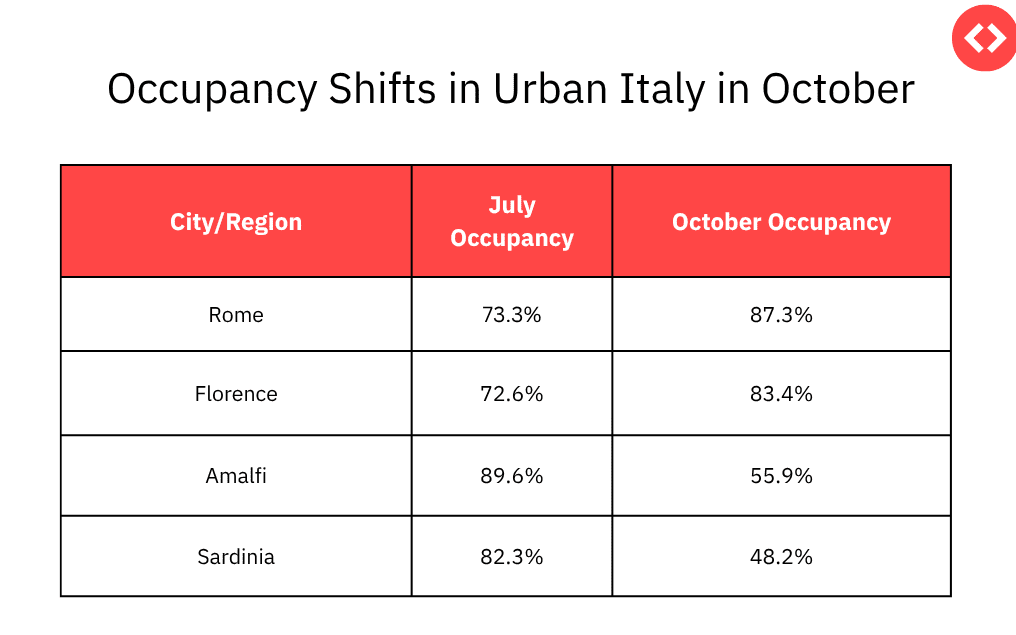

Coastal Prices Dip, Urban ADRs Stay Strong in October
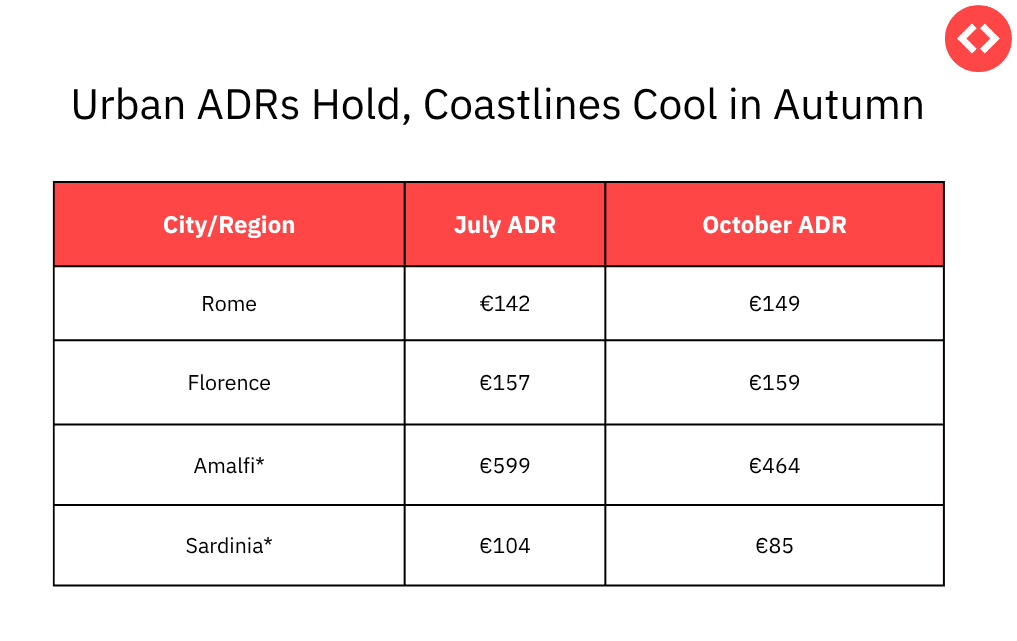

Revenue Shifts Inland: Cities Rise as Coasts Lose Autumn Momentum
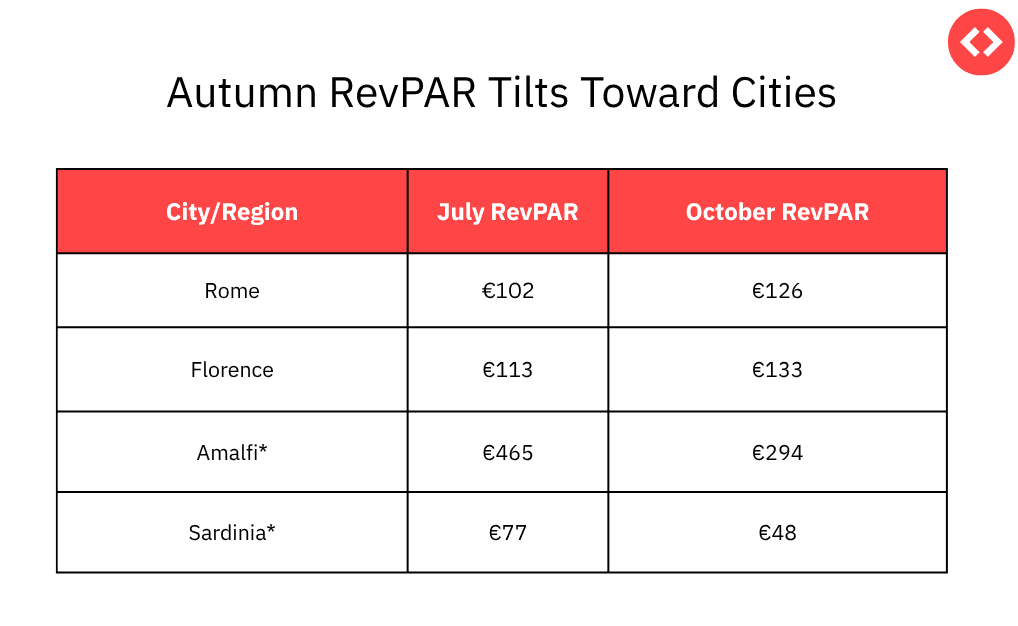

Key Insights: Autumn Travel Shifts Revenue from Coast to City
The data clearly shows a seasonal shift in traveler demand from Italy’s coastal destinations to its urban centers:
- Occupancy in Rome climbs from 73.3% in July to 87.3% in October, and in Florence from 72.6% to 83.4%. Meanwhile, Amalfi’s share drops from 89.6% to 55.9%, and Sardinia’s share from 82.3% to just 48.2%.
- ADR (Average Daily Rate) in cities remains stable or grows—Rome holds strong at €151 in July to €153 in October, while Florence increases from €140 to €150. In contrast, Amalfi’s ADR falls from €302 to €182, and Sardinia’s from €228 to €126.
- RevPAR (Revenue per Available Room) highlights the impact: Rome’s rises from €111 to €134, and Florence’s from €102 to €125, while Amalfi’s drops sharply from €271 to €102, and Sardinia’s from €188 to €61.
Takeaway: Urban destinations see consistent or improved performance in October, while coastal areas face a steep post-summer decline. Property managers in cities are well-positioned to capture off-season demand, while coastal hosts may need to adjust pricing, extend minimum stays, or target mid-term renters to stabilize revenue.
Reddit user u/traveltoitaly in a thread about October travel noted:
“October is honestly the best month to visit Rome or Florence. The weather is perfect, and you can actually walk into the Uffizi without standing in line for an hour.”
Quora travelers echo this. One user wrote:
“Autumn is ideal for museum hopping and food festivals. You miss the oppressive heat and still enjoy beautiful days.”
These testimonials align with performance trends across Italian cities—October is less about beaches and more about boots-on-street culture seekers, wine lovers, and slow travelers.
PriceLabs Market Dashboard
Ready to unlock the power of data? Try PriceLabs Market Dashboards today and turn insights into action for your vacation rental success!
Try Now!What are Some Strategies to Maximize Autumn Revenue and Hit Vacation Rental Occupancy Goals in Italy?
So, what can you do now in July to maintain strong bookings in October and reach your vacation rental occupancy goals?
1. Fine-Tune Your Pricing Now (Not in September)
Dynamic pricing tools, such as PriceLabs, enable you to anticipate seasonal shifts before they occur, allowing you to adjust your pricing strategy accordingly. Instead of dropping your rate in a panic in late September, PriceLabs uses real-time market data and historical trends to suggest optimized pricing for your shoulder season pricing strategy well in advance.
Here’s how you can act:
- Set seasonal base rates: Adjust base rates according to autumn demand (e.g., maintain higher rates in cities like Rome and lower rates in coastal towns).
- Use occupancy-based rules: Drop prices only when specific nights remain vacant as check-in nears.
- Automate discounts: Apply early bird offers to bookings made 90 days or more in advance, and last-minute discounts to bookings made 2–3 days prior.
Pro-tip: In PriceLabs, set a last-minute discount rule that offers 15% off within 5 days of check-in, but only on nights that remain vacant after September 25.
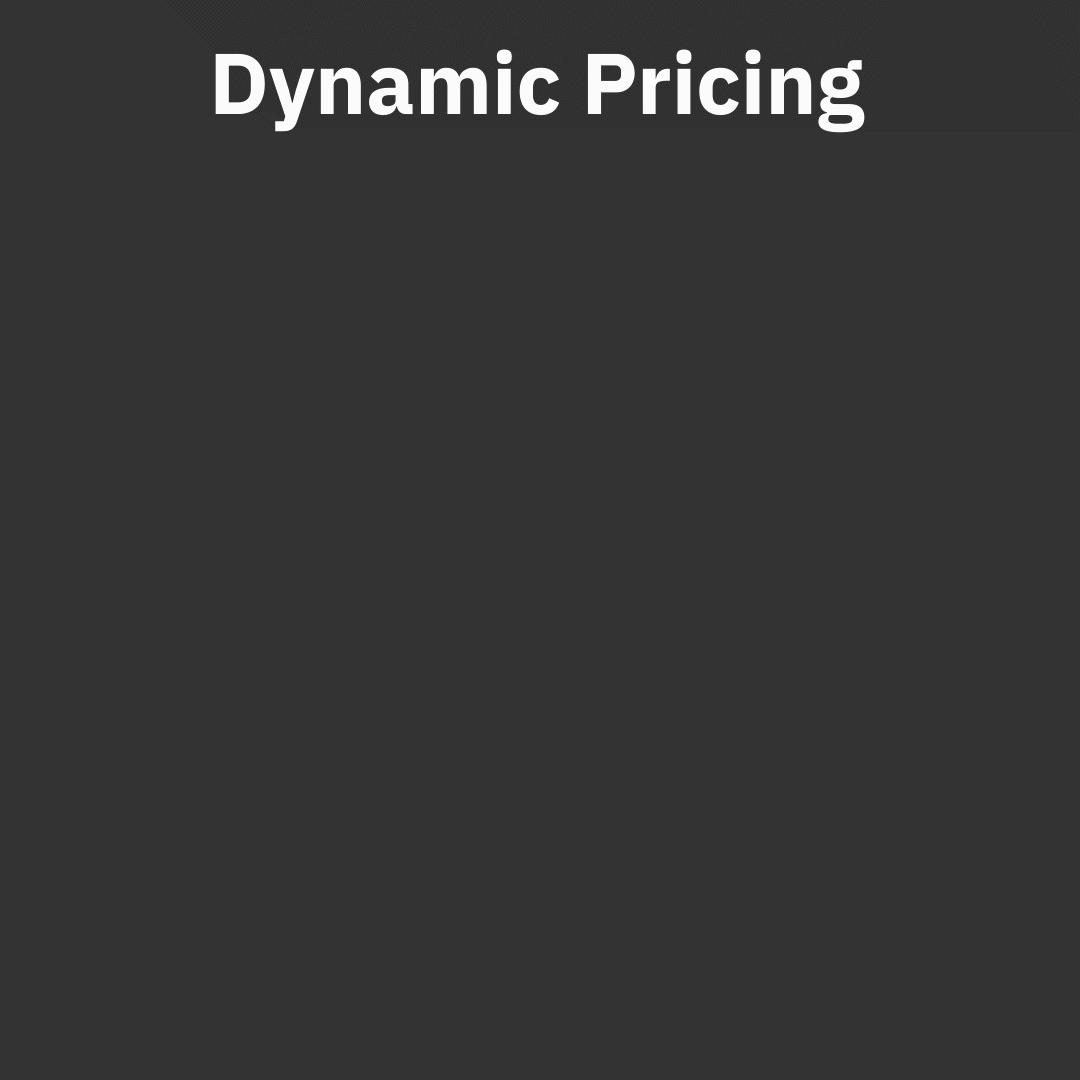

2. Adjust Minimum Stays
Fall travelers—especially those traveling domestically—are more likely to take quick weekend breaks than long vacations. To maximize autumn revenue, lower your minimum stay requirements to 2–3 nights for October, especially mid-week. You can automate this with PriceLabs’ “minimum stay profiles.”
As one Reddit user in r/ItalyTravel shared:
“I booked a weekend in Milan in October for a food festival. Wouldn’t have stayed if they forced a 5-night minimum. Two nights was perfect!”
3. Bundle Experiences, Not Just Discounts
Instead of simply offering 10% off, create experience-driven packages to increase fall bookings Italy:
- “Truffle Hunt Weekend in Umbria: 3 Nights + Private Tour”
- “Rome in Autumn: Stay 4, Pay 3 + Skip-the-Line Vatican Tour”
Tourists in autumn are seeking not just accommodation, but also local immersion. They want to slow down, enjoy wine tastings, go foraging, or take cooking classes.
4. Showcase Autumn Vibes in Your Listings
Update your listing photos in July to reflect what October has to offer: cozy interiors, scenic vineyards, food markets, and fireplaces, rather than poolside lounges. Mention nearby harvest festivals and off-season activities. Highlight features like:
- Fireplaces or heated floors
- Local partnerships (spa treatments, chef services)
- Wine tasting rooms or terraces with fall views
Add phrases like “autumn getaway,” “cozy wine escape,” or “October truffle season” to your title and description.
5. Inspire Early Bookings Through Email Campaigns
Use your July calendar to re-engage past guests. Offer them a special rate for a fall return trip or upsell autumn-only experiences.
- Subject line: “October in Italy? Here’s a Treat Just for You!”
- Include a fall itinerary and a special link to book directly.
PriceLabs’ integration with PMS systems and channel managers enables you to sync rates across platforms and automatically flag early bird or last-minute promotions.
6. Weekday Incentives for Off-Peak Days
Even in high-demand urban markets, weekdays tend to lag. Offer:
- “3 for 2” mid-week deals
- Free late checkout for arrivals on Monday–Wednesday
- Local experience add-ons (cooking class, market tour)
Your Short-term Rental’s July Checklist for a Profitable October
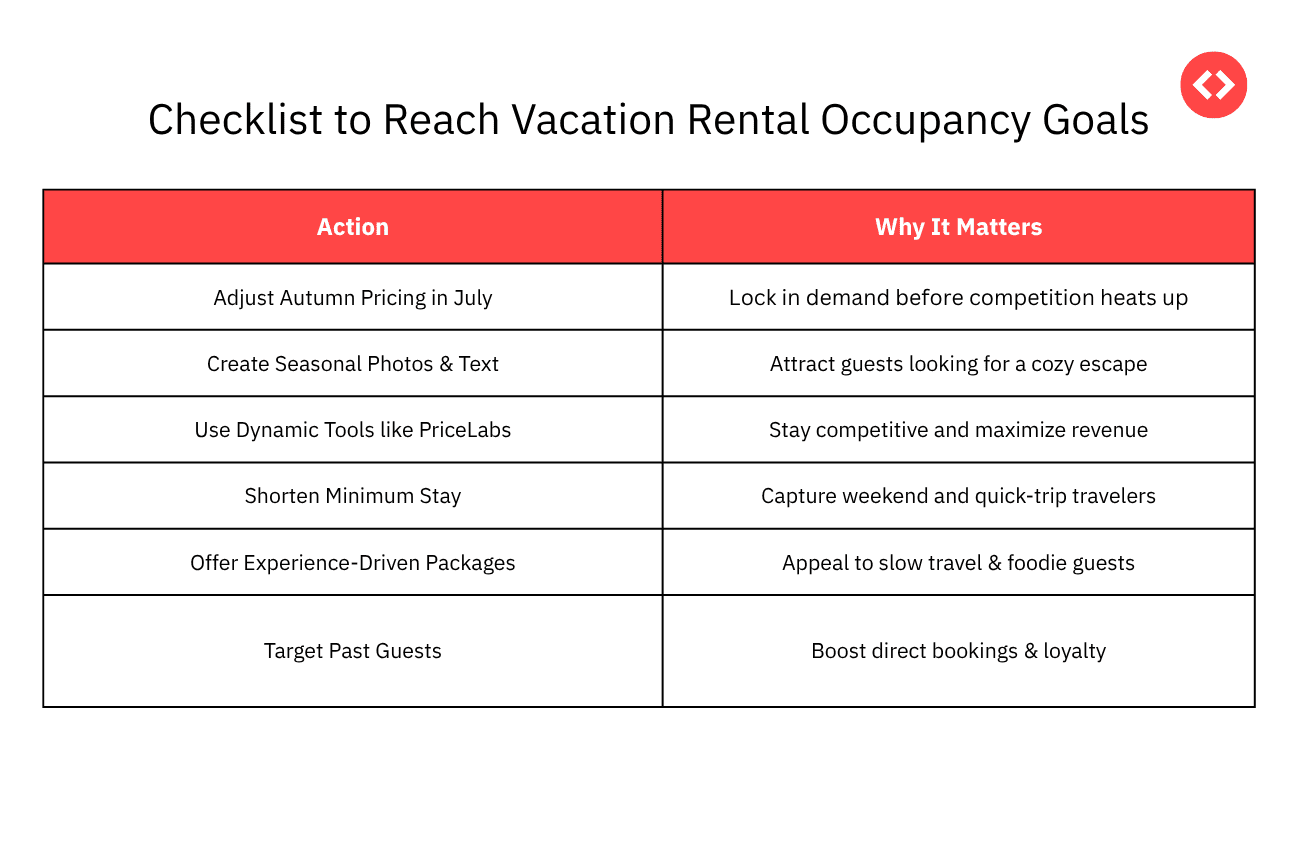

Final Thoughts On How Italian Vacation Rentals Can Prepare For October & Beyond
Italy’s autumn is no longer an off-season—it’s just a different kind of high season, especially in cities. Planning now, in July, helps you stay ahead of the curve. The guests are out there, looking for warm, authentic, and crowd-free experiences. With the right strategies, you can ensure they book with you—and help you reach your vacation rental occupancy goals.
And with PriceLabs, you don’t have to do it alone. Automate smart pricing, optimize your lead time offers, and craft customized promotions—all in one place.







